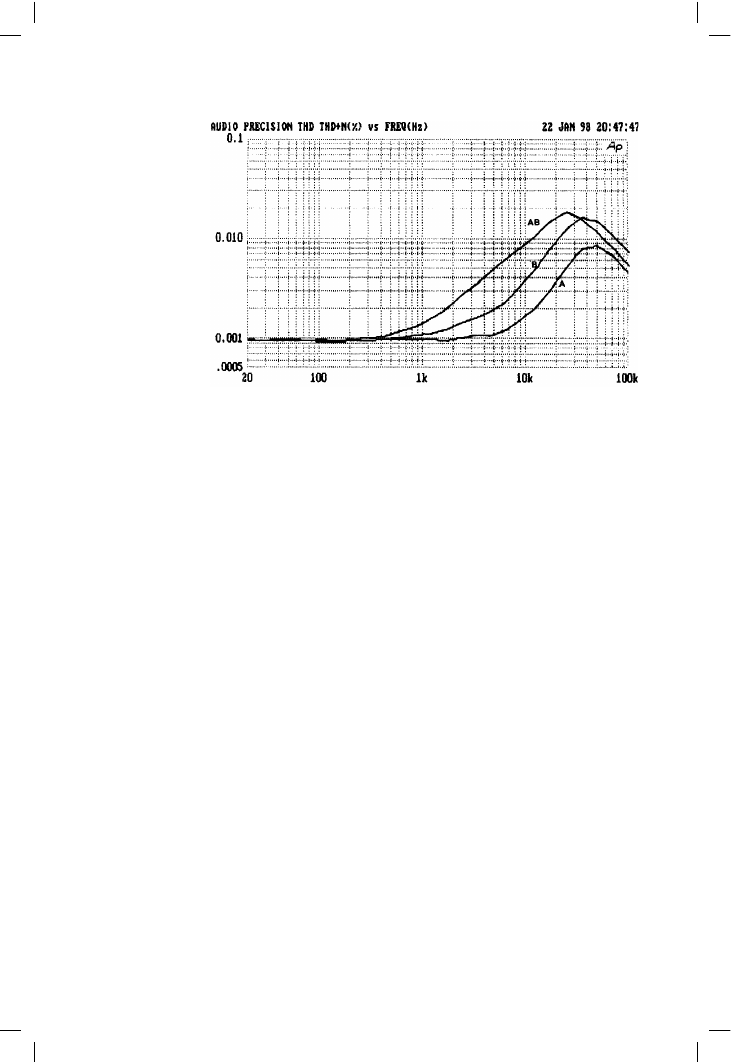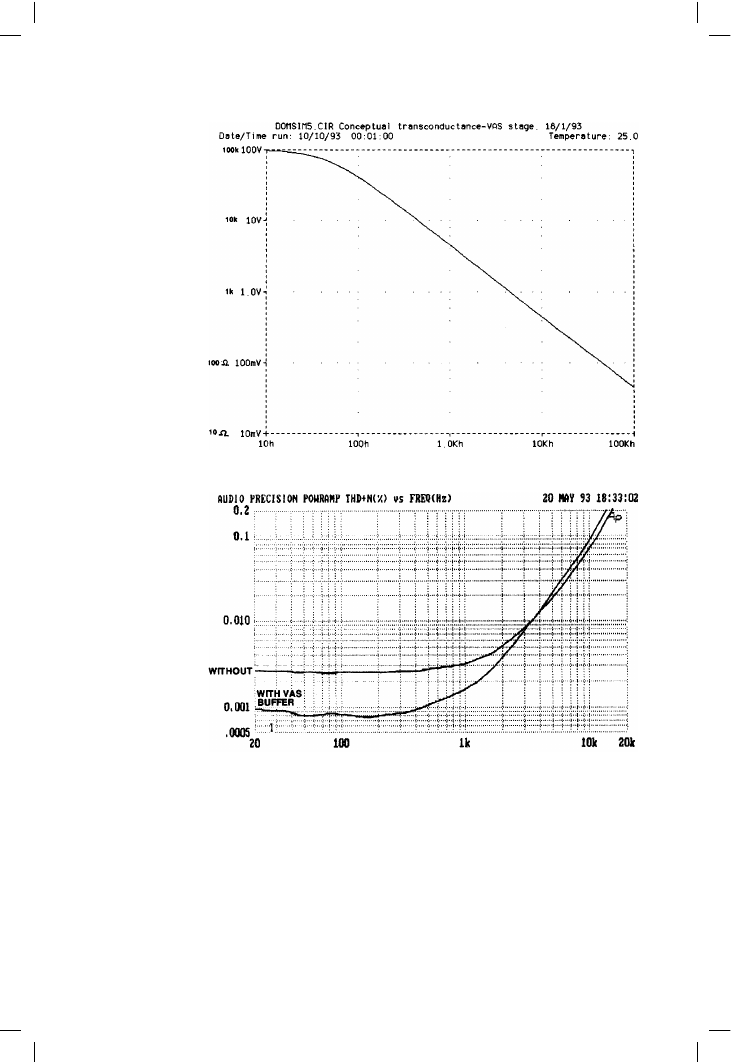ВУЗ: Казахская Национальная Академия Искусств им. Т. Жургенова
Категория: Учебное пособие
Дисциплина: Не указана
Добавлен: 03.02.2019
Просмотров: 17408
Скачиваний: 18

Audio Power Amplifier Design Handbook
are the result of attending to all of the major sources of distortion, rather
than just one or two. I have at the time of writing personally built 12 models
of the CFP version, and performance showed little variation.
Here the closed-loop distortion is much greater than that produced by the
small-signal stages alone; however if the input pair is badly designed its HF
distortion can easily exceed that caused by the output stage.
Our feedback-factor here is a minimum of 70
× across the band (being
much higher at LF) and the output stages examined above are mostly
capable of less than 0.1% THD open-loop. It seems a combination of these
should yield a closed loop distortion at least 70 times better, i.e. below
0.001% from 10 Hz to 20 kHz. This happy outcome fails to materialise, and
we had better find out why . . .
Firstly, when an amplifier with a frequency-dependent NFB factor generates
distortion, the reduction is not that due to the NFB factor at the fundamental
frequency, but the amount available at the frequency of the harmonic in
question. A typical amplifier with o/l gain rolling-off at 6 dB/octave will be
half as effective at reducing fourth-harmonic distortion as it is at reducing
the second harmonic. LSN is largely third (and possibly second) harmonic,
and so NFB will deal with this effectively. However, both crossover and
switchoff distortions generate high-order harmonics significant up to at
least the nineteenth and these receive much less linearisation. As the
fundamental moves up in frequency the harmonics do too, and benefit
from even less feedback. This is the reason for the differentiated look to
many distortion residuals; higher harmonics are emphasised at the rate of
6 db/octave.
Here is a real example of the inability of NFB to cure all possible amplifier
ills. To reduce this HF distortion we must reduce the crossover gain-
deviations of the output stage before closing the loop. There seems no
obvious way to do this by minor modifications to any of the conventional
output stages; we can only optimise the quiescent current.
As I stated on page 33, Class AB is generally not a Good Thing, as it gives
more distortion than Class B, rather than less, and so will not help us. Figure
5.51 makes this very clear for the closed-loop case; Class-AB clearly gives
the worst performance. (As before, the AB quiescent was set for 50:50 m/s
ratio of the gm-doubling artefacts on the residual.)
160
Table 5.6
Summary of
closed-loop amp
performance
1 kHz
10 kHz
EF
0.0019%
0.013%
CFP
0.0008%
0.005%
Quasi Bax
0.0015%
0.015%

The output stage I
Conclusions
To summarise:
1 Class-AB is best avoided. Use pure Class-A or B, as AB will always have
more distortion than either,
2 FET outputs offer freedom from some BJT problems, but in general have
poorer linearity and cost more,
3 the distortion generated by a Blameless amplifier driving an 8 ! load is
almost wholly due to the effects of crossover and switching distortion.
This does not hold for 4 ! or lower loads, where third-harmonic on the
residual shows the presence of large-signal non-linearity, caused by beta-
loss at high output currents.
References
1. Mann The Texan 20+20 Watt Stereo Amplifier Practical Wireless, May
1972, p. 48 (Output stage with gain).
2. Takahashi Design and Construction of High Slew Rate Amplifiers
Preprint No. 1348 (A-4) for 60th AES Convention 1978 (Class-B small-
signal stages).
3. Hawksford Distortion Correction in Audio Power Amplifiers Journ.
Audio Eng. Soc. Jan/Feb 1981, p. 27 (Error-correction).
4. Walker, P Current-Dumping Audio Amplifier Wireless World 1975,
pp. 560–562.
5. Blomley New Approach To Class-B Wireless World, Feb 1971, p. 57
and Mar 1971, pp. 127–131.
6. Otala An Audio Power Amplifier for Ultimate Quality Requirements
IEEE Trans on Audio and Electroacoustics, Dec 1973, p. 548.
7. Lin, H Electronics, Sept 1956, pp. 173–175 (Quasi-comp).
161
Figure 5.51
Closed-loop CFP
amp. Setting
quiescent for Class
AB gives more HF
THD than either
Class A or B

Audio Power Amplifier Design Handbook
8. Baxandall, P Symmetry in Class B Letters, Wireless World Sept 1969,
p. 416 (Baxandall diode).
9. Gray and Meyer Analysis and Design of Analog Integrated Circuits
Wiley 1984, p. 172.
10. Crecraft et al Electronics pub Chapman and Hall 1993, p. 538.
11. Oliver Distortion In Complementary-Pair Class-B Amps Hewlett-
Packard Journal, Feb 1971, p. 11.
12. Blomley, P New Approach To Class-B Wireless World, Feb 1971,
p. 57.
13. Alves, J Power Bandwidth Limitations in Audio Amplifiers IEEE Trans
on Broadcast and TV, March 1973, p. 79.
14. Baxandall, P Symmetry in Class B Letters, Wireless World Sept 1969,
p. 416 (Baxandall diode).
162

6
The output stage II
Distortion number 4: VAS loading distortion
Distortion 4 is that which results from the loading of the Voltage Amplifier
Stage (VAS) by the non-linear input impedance of a Class-B output stage.
This was looked at in Chapter 4 from the point of view of the VAS, where
it was shown that since the VAS provides all the voltage gain, its collector
impedance tends to be high. This renders it vulnerable to non-linear
loading unless it is buffered or otherwise protected.
The VAS is routinely (though usually unknowingly) linearised by applying
local negative-feedback via the dominant-pole Miller capacitor Cdom, and
this is a powerful argument against any other form of compensation. If VAS
distortion still adds significantly to the amplifier total, then the local open-
loop gain of the VAS stage can be raised to increase the local feedback
factor. The obvious method is to raise the impedance at the VAS collector,
and so the gain, by cascoding. However, if this is done without buffering
the output stage loading will render the cascoding almost completely
ineffective. Using a VAS-buffer eliminates this problem.
As explained in Chapter 4, the VAS collector impedance, while high at LF
compared with other circuit nodes, falls with frequency as soon as Cdom
takes effect, and so Distortion 4 is usually only visible at LF. It is also often
masked by the increase in output stage distortion above dominant-pole
frequency P1 as the amount of global NFB reduces.
The fall in VAS impedance with frequency is demonstrated in Figure 6.1,
obtained from the Spice conceptual model in Chapter 4, with values
appropriate to real life. The LF impedance is basically that of the VAS
collector resistance, but halves with each octave once P1 is reached. By
3 kHz the impedance is down to 1 k!, and still falling. Nevertheless, it
usually remains high enough for the input impedance of a Class-B output
163

Audio Power Amplifier Design Handbook
stage to significantly degrade linearity, the actual effect being shown in
Figure 6.2.
In Chapter 4 it was shown that as an alternative to cascoding, an effective
means of linearising the VAS is to add an emitter-follower within the VAS
local feedback loop, increasing the local NFB factor by raising effective
beta rather than the collector impedance. As well as good VAS linearity, this
establishes a much lower VAS collector impedance across the audio band,
and is much more resistant to Distortion 4 than the cascode version. VAS
164
Figure 6.1
Distortion 4; the
impedance at the VAS
collector falls at 6 dB/
octave with frequency
Figure 6.2
Distortion 4 in action;
the lower trace shows
the result of its
elimination by the use
of a VAS-buffer